CD133 expression and cancer stem cells predict prognosis in high-grade oligodendroglial tumors
- PMID: 18371181
- PMCID: PMC8095518
- DOI: 10.1111/j.1750-3639.2008.00130.x
CD133 expression and cancer stem cells predict prognosis in high-grade oligodendroglial tumors
Abstract
High-grade oligodendroglial tumors, that is, anaplastic oligodendroglial tumors and glioblastomas with oligodendroglial component, differ significantly in terms of prognosis and response to chemotherapy. Differentiation might be difficult because the histological differences are vague and reliable markers are not established. We correlated the presence of putative cancer stem cells (CSC) in high-grade oligodendroglial tumors (WHO grades III and IV) with clinical outcome. Tumors with favorable prognosis neither contained CSC nor did they show CD133 expression. Tumor cells resembled lineage-restricted progenitor cells with limited proliferative capacity and differentiation profile. In contrast, CD133 expression and stem cell-like tumor cells characterized tumors with poor prognosis. They showed neurosphere-like growth, differentiated into cells of all neural lineages, and were tumorigenic in nude mice. In our series, CSC and expression of CD133 predicted the clinical course of disease better than the histological grading. To confirm these results, we retrospectively analyzed 36 high-grade oligodendroglial tumors. Again, CD133 expression indicated shorter survival and predicted clinical outcome more reliable than the histological assessment. Our data show that detection of CSC and expression of CD133 is predictive of prognosis in high-grade oligodendroglial tumors. The presence or absence of CD133(+) CSC might explain the crucial biological difference between WHO grade III and IV oligodendroglial tumors.
Figures




References
-
- Bao S, Wu Q, McLendon RE, Hao Y, Shi Q, Hjelmeland AB et al (2006) Glioma stem cells promote radioresistance by preferential activation of the DNA damage response. Nature 444:756–760. - PubMed
-
- Beier D, Hau P, Proescholdt M, Lohmeier A, Wischhusen J, Oefner PJ et al (2007) CD133+ and CD133‐ glioblastoma‐derived cancer stem cells show differential growth characteristics and molecular profiles. Cancer Res 67:4010–4015. - PubMed
-
- Bjerkvig R, Tysnes BB, Aboody KS, Najbauer J, Terzis AJ (2005) Opinion: the origin of the cancer stem cell: current controversies and new insights. Nat Rev Cancer 5:899–904. - PubMed
-
- Cairncross JG, Macdonald DR (1988) Successful chemotherapy for recurrent malignant oligodendroglioma. Ann Neurol 23:360–364. - PubMed
-
- Clarke MF (2005) Self‐renewal and solid‐tumor stem cells. Biol Blood Marrow Transpl 11:14–16. - PubMed
MeSH terms
Substances
LinkOut - more resources
Full Text Sources
Medical
Research Materials

